In 2015 I caught a 4-pound Shorthead Redhorse (Moxosoma macrolepidotum) that would have been a new Illinois state record if I had stopped fishing, found a store with a certified scale, and got it weighed. I missed the record by just 1/100 of a pound. The state record, 3.74 pounds, was set in 2008 by Andrew Chione, whose brother John had set the Silver Redhorse (M. anisurum) record the day before. I wrote about them in 2013.
In my 2015 state record post I asked a number of rhetorical questions about the meaning of records and what I might do if it happened again. Well it has. Three times. And some questions have been answered.
The first of those catches (so my second record breaker) was an April 2018 pre-spawn female just barely under 4 pounds. She was released out of fear that the same thing would happen, and because beating a fish record by just a few ounces is not particularly noteworthy. Fish records are not like track and field records. If you shave a few seconds off the time it takes a human to run a mile or jump a couple feet further than any human has ever jumped, you have done something unique and unequalled. If you catch a fish that’s basically identical to what someone else caught, except that it’s carrying a few extra eggs or hasn’t digested its last big meal, you have not crossed into new territory. No one is going to say “I didn’t know they could get that big here,” because everyone does know it thanks to the record on the books.
I caught the third record breaker, weighing exactly 4 pounds, in November of 2020. Due to its size, I assumed it was a female until I discovered, while preparing it for dinner, a quarter pound of milt inside. That’s fish semen, and yes, I weighed it. One-sixteenth of his body weight. Divide your own weight by 16 and imagine carrying that much of whichever reproductive cells your body produces. Yikes.
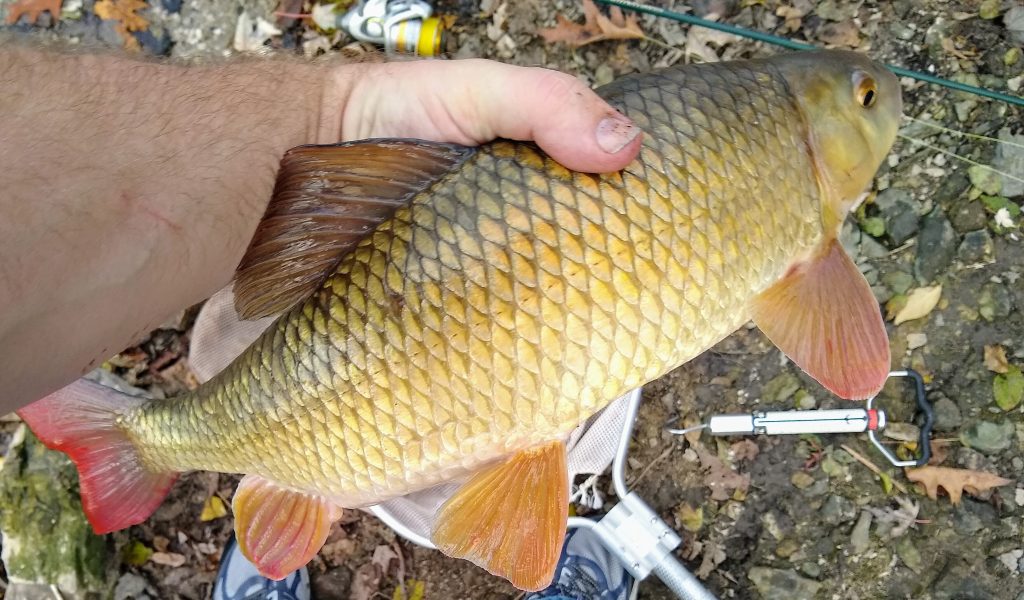
It is unusual for males to be as large as females, and especially for them to match the size of the biggest females. At 4 pounds, this male (which had .25 ounces/7 grams of milt in him) was definitely a notable fish.
Not Interested in Records
After my 2015 mistakes I didn’t think I would pursue another record. I was ashamed of the pointless ego trip and really couldn’t see a reason to repeat it.
Or Am I?
Then, on my first day of fishing in 2021, a mostly cold, drizzly day that mostly failed to produce fish despite the hundreds of Shortheads swimming past on their way upstream to spawn, I had to rethink the whole issue.
The day started with the sighting of a bright red tail splashing out of the water in a promising spot, but that seemingly good omen was followed by nothing but a small carp for my friend and a smallmouth bass shorter than my hand for me. My wading boots were too tight, and my feet hurt. I was hungry. My assumptions—that I would catch a ton, keep a few and eat redhorse for dinner—were doing what assumptions do.
We drove around and tried different parts of the creek with no luck. I got cold and frustrated.
Around 4:00 in the afternoon, the sun came out and improved my mood. In an effort to start a trend, we ate sandwiches. The redhorses resisted the peer pressure and went on ignoring food.
Facing east, into the sun, blinded me both literally (burning out my eyes with lasers when I looked into the sun’s reflection on the surface of the water) and figuratively (because that bright surface blocked my view of the creek bottom and the fish). I repeatedly spooked unseen fish that had been holding right in front of me, noticing them only when they shot into the shade of the bridge, where I could see into the water. Each time, I tried to make an educated guess about where they had been sitting and where they might be coming from.
I Only Figured It Out Once
Or maybe I just got lucky. A bad cast into the pool under the bridge scared some Shortheads downstream, so I quickly re-cast to where I thought they might stop. I couldn’t see through the reflection, couldn’t be sure of the depth or the structure of the creek bed. I must have guessed correctly, though, because for the first (and so far only) time this year I felt the signature redhorse tap, tap, TAP! and made a solid connection.
The amount of resistance and the strength of the pull made me suspect I had a carp or big catfish until I saw sides flashing gold and silver. It looked too big to be a Shorthead, so I was excited at the prospect of catching either a Greater (M. valenciennesi) or River (M. carinatum) redhorse. Both are extremely unlikely in that spot, and both are absent from my lifelist.
In the net it was an obvious shorthead (except for being impossibly large). Weighed in the bag of my net she was an inconceivable 6-6.5 pounds. My scale only has marks for full and half pounds, and she was not holding still, so the needle was bouncing. (I later confirmed its accuracy using a known weight.) I tried calling the DNR immediately in hopes of getting her weighed and certified before releasing her. I wasn’t even a mile from their nearest office, but it was 4:30 on a Friday during COVID and I found no one.
It might be nice to say that I didn’t mean for that fish to die, that I just waited a little too long to release her, or that she was old and decrepit or something, but I can’t. I think I had decided what I was going to do as soon as I clearly saw her absurd size.
But what do you suppose I did, having just caught one of the biggest Shortheads ever seen—bigger than just about every accurately identified world and state record? If you’ve read the 2015 story, you’ve probably already guessed.
Just like last time, I didn’t get to a scale as quickly as I should have. Instead of going immediately to the car and heading for a town with a grocery store, I kept fishing. I still wanted that dinner. Plus, now they were biting and it was about to get good! They weren’t and it didn’t.
Neither of us caught more fish that day. By the time I got home there was no store with a meat department still open, and that meant no certified scale.
Weigh-in
She stayed on ice, losing weight, until I took her to the butcher counter at my local grocery store the next morning. I carried her up to the counter and said to the butcher, “I have what will almost certainly be the weirdest question you get all day.” She said, “Oh, I don’t know about that,” and I explained what I needed. I didn’t ask, but I’ll bet there were no weirder questions that day. On the certified scale the redhorse weighed 4.80 pounds (4 pounds, 12.8 ounces).
Over a pound higher than the Illinois record and only about half a pound below the IGFA world record.
It took another couple days to set up a meeting with a DNR biologist to have the identification certified, then I sent in the paperwork to claim the record. I think I’ll get a certificate or something. Maybe a secret password that gets me into the top-secret DNR parties no one is supposed to know about.
Other Records
Seeing a Shorthead of such unbelievable proportions sent me down the information mineshaft to try to figure out what, if anything, we can say about how she fits into the known Shorthead universe. I’m still digging, but here’s what I have so far.
I have not found many verified or verifiable reports of Shortheads over 4.5 pounds. The largest specimens mentioned by fisheries biologists I contacted were around 4 pounds. John Lyons, former Wisconsin DNR fisheries biologist, wrote, “I’ve collected and measured thousands of Shortheads on the Lower Wisconsin and dozens to hundreds from most of the other rivers in the state, and I’m not sure I’ve seen any fish much above 4 lbs. Typical maximum weight, even for an egg-laden female, is more like 2.5-3 lbs.” (More on John here) A Missouri biologist said the biggest specimen he was aware of in that state was 4.2 pounds. Some older books mention vaguely that Shortheads can get to 24 inches and 8-10 pounds, but without supporting evidence. Becker’s Fishes of Wisconsin mentions a 6-pounder but not exactly where or when it was captured, or how solid the identification or measurement were. (It’s on page 668. There’s a link to the whole book in the Fish Resources section of the bar on the right side of this page or way down at the bottom if you’re looking at the mobile version.)
I was able to find state record Shortheads for eight US states other than Illinois and provincial records for two Canadian provinces. A surprising number of states don’t differentiate between redhorse species, a few just lump all suckers into one record, and some don’t have any sucker state records at all. That’s just weird, but it’s another symptom of how little attention and respect these fish have traditionally received.
Here they are: Iowa, 3.65 pounds; Missouri, 2 pounds 14 ounces; Montana, 4.68 pounds; South Dakota, 4 pounds 10 ounces; Wisconsin, 3 pounds 4 ounces; Ontario, 27.5 inches (so not actually a Shorthead); Quebec, 19.25 inches, (no weight). Tennessee has a record for the closely related Smallmouth Redhorse (M. breviceps), at 1 pound 10 ounces. New York has a retired record of 11 pounds 11 ounces. Easy to see why they retired it: it wasn’t a Shorthead.
If you’re keeping track, you noticed that that is only seven states. Minnesota gets a little extra coverage, below.
World Records
The IGFA world record is 5 pounds, 6 ounces (2.46 kg) (https://igfa.org/igfa-world-records-search/…), caught in 1988 from the Prairie River in Minnesota by Greg Clusiau. Until a recent Friday afternoon, I had some doubt that the fish was actually a Shorthead, but now I know that’s possible.
The Freshwater Fishing Hall of Fame lists a bunch of almost definitely erroneous Shorthead world records: 11 lbs 5 oz (WI), 11 lbs 2 oz (WI), 9 lbs 5 oz (MI), and 8 lbs 13 oz, 8 lbs 5 oz, and 8 lbs 4 oz (all 3 from Ontario).* All of these fish were likely either Greater or River redhorses. While a 6-pound Shorthead is nearly inconceivable, 8 pounds is probably impossible. Nine- and 11-pound Shortheads are pure fantasy. (They also list several fly fishing records, all of which probably really were Shortheads as they are normal weights.) [*The most recent copy of their record book I could consult was from 2009. I will update when I find more recent info. All of the records are from the 1980s and 90s.]
On May 20, 2005, a man in Minnesota caught a 12 lb 11 oz redhorse that got all kinds of press as a world record Shorthead. It was actually a Greater, and is now the MN state record and the IGFA world record for that species. Unfortunately, you still find the articles when you search for information about big Shortheads, and I haven’t seen any coverage of it being re-identified and certified as a world record. (Oddly, the MN state record River Redhorse was caught the same day and weighed 12 lbs 10 oz.) Minnesota’s Shorthead record (7 lbs 15 oz) is also misidentified. As it was caught in 1983, I don’t know if there’s a photo that could be used to confirm this. (Not to pick on Minnesota, but their record Golden Redhorse is actually a Silver: perhamfocus.com…minnesota-fish.)
I’m not listing questionable and incorrect records in order to claim that my fish was the greatest Shorthead of all time (but I will point out that it is the biggest state record—nice tries, MT and SD). It just really bothers me when people who should know better get identifications wrong and muddy the records with inaccurate information. It was a string of such situations in the early 2000s, starting (I think) with the misidentified Minnesota Greater, that inspired me to make my Redhorse ID cheatsheets (which you can download here) and then to create this very site to distribute them.
If an angler gets the ID wrong when telling friends about a fish, no harm is done. It’s different when a state agency gets it wrong, and that happens too frequently (and not just with redhorses). It’s not surprising, since state natural resources agencies tend to put most of their effort into the species the most people know and care about: bass, pike, muskies, trout, etc. Suckers and other “rough” fish have been an afterthought for decades, and most of the agencies’ biologists don’t have any reason (or time, probably) to develop expertise in the nuances of non-game fish identification. But the agencies have a responsibility to their constituents to be accurate, and they ought to try to be a trustworthy example to everyone in the state of the importance of knowing how to identify the animals that might be encountered. To that end, every state should have at least a few biologists who together are able identify all the species found in the state.
I do not believe my new Illinois state record was the biggest Shorthead that ever lived. Until I see some evidence to the contrary (and I am actively seeking it), however, I will say that she might be, as one biologist suggested, the biggest verifiable Shorthead Redhorse on record.

A quick look at the annuli on these scales led Dr. Jenkins to say the fish might have been 20 years old or more. More precise aging will follow, using the scales in combination with other methods.
She was an old fish—possibly 20 years or more—and I feel bad about ending her extraordinarily strong life. She appeared to be in good shape and might have lived to spawn for several more years. I don’t know what the accepted maximum lifespan for the species is—I don’t think anyone really does—but 20 feels exceptional. Killing her removed some good genes from the pool. The only thing that mitigates any guilt I might feel about that is the fact that I’ve caught those other above average Shortheads in the same creek, and it’s pretty unlikely they were all her offspring.
Further, her death may be of some scientific benefit. After she was certified, I froze and packed her for her longest migration yet. A few days later, she reached Virginia and the lab of the redhorse authority, Dr. Robert Jenkins, Professor Emeritus at Roanoke College. He measured her more accurately than I could ever do with a yardstick or 25-foot heavy duty yellow tape measure. Official measurements: Standard Length (SL)=427 mm, Total Length (TL)=533 mm, or almost exactly 21 inches. He is preparing her skeleton, which will be entered into a museum specimen collection, and is using several techniques to determine her age more precisely. I will update this post when I know more.
I still question my decision, but I believe a fish that breaks the record by more than a pound is significant enough to warrant doing what I did. I won’t pretend that this was not an act of ego, but I can accept that. If nothing else, it means I’ll probably never kill another Shorthead to set a record. I’ll still keep some to eat now and then, but not the extra-large ones—I want their genes to keep spreading.
Finally, one shot of her extraordinary belly (post mortem):
UPDATE: Dale Bowman wrote about my fish and the story got a full page in the Chicago Sun-Times, May 1, 2021. It’s online at https://chicago.suntimes.com/2021/4/30/22411610/illinois-record-shorthead-redhorse-olaf-nelson-shorthead-heaviest-one-verified.




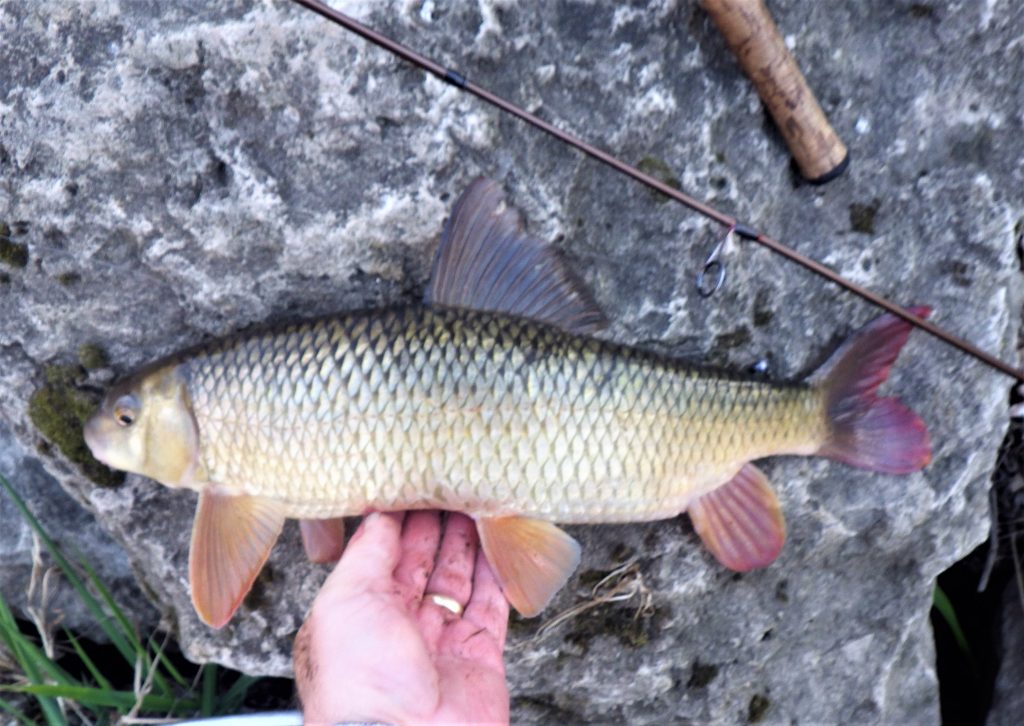
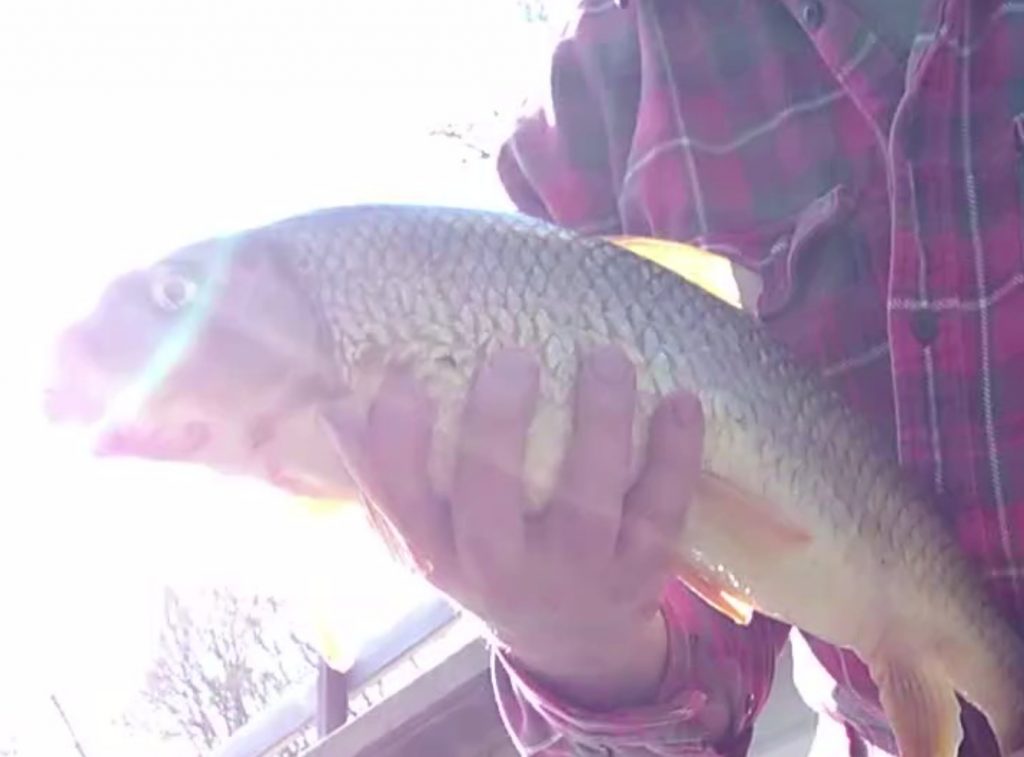

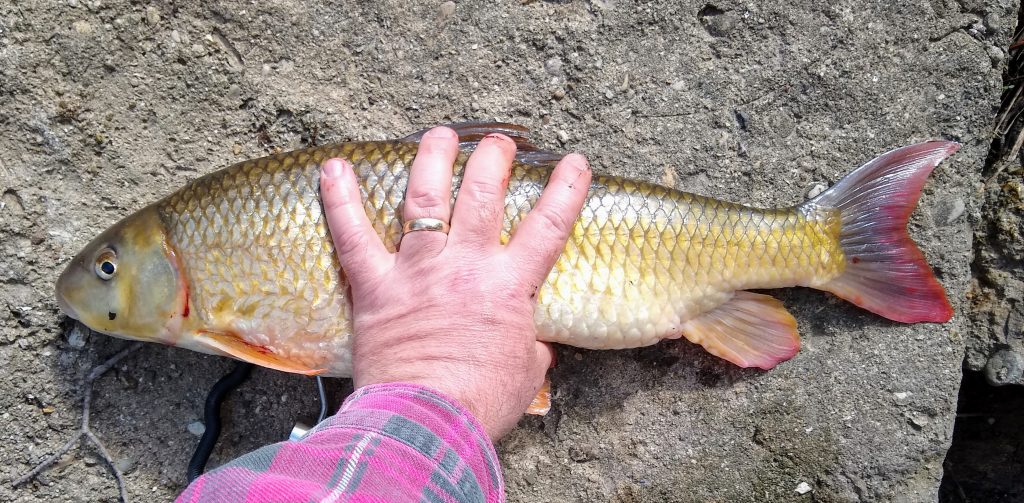
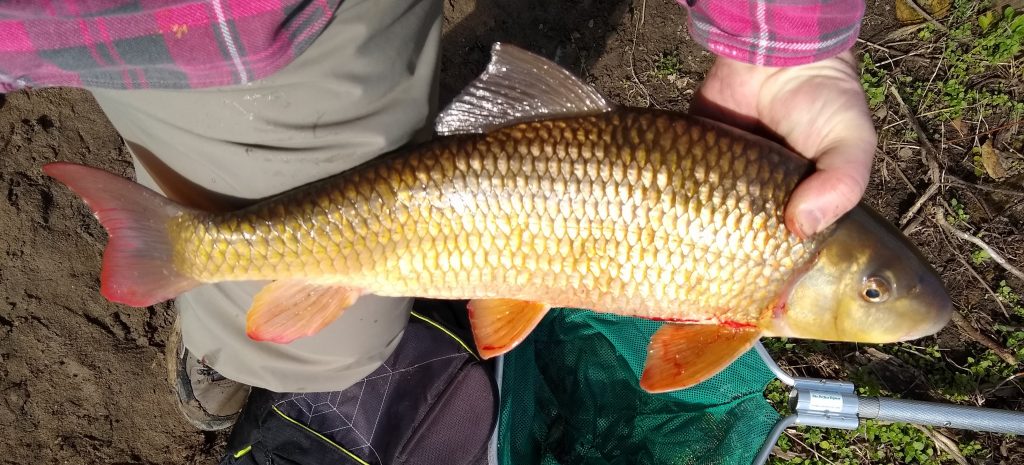


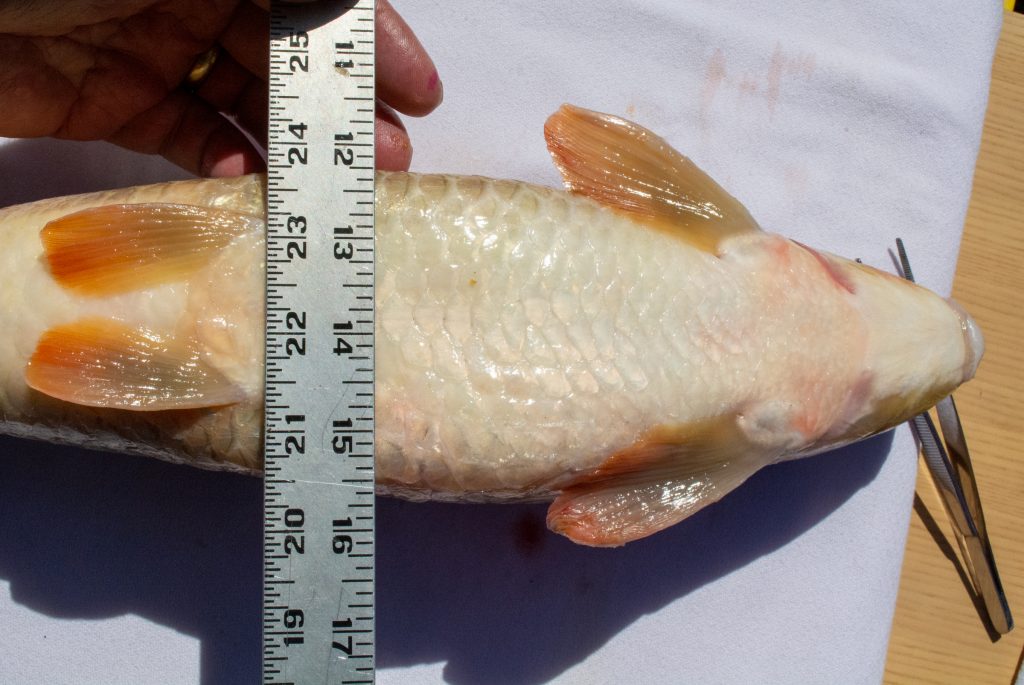









I would say that this maybe a vastly underaged. You should look at the otoliths for a better idea of sucker growth. We have been guilty of really underaging the suckers when scales are used. See one of the current papers in suckers age and growth Radford et al. 2021 is a good one on blue suckers.
She’s being aged using otoliths and opercles. The scale-based number was just a quick estimate and Bob was clear that it didn’t necessarily mean anything. Thanks for the reference. I’m always up for a new Blue Sucker article.